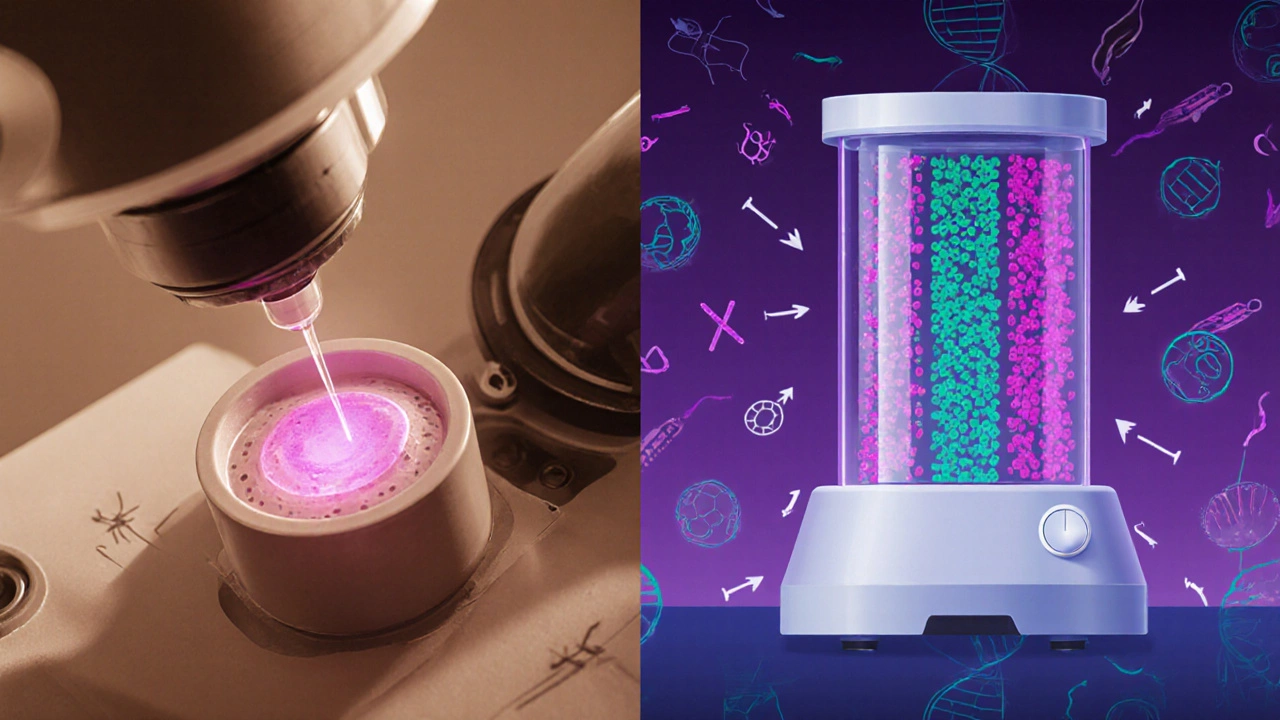
Gender Selection in IVF: Methods, Success Rates, and Legal Basics
IVF Gender Selection Cost Calculator
Estimate Your IVF Gender Selection Costs
The cost of gender selection through IVF varies based on the method and location. Enter your details below for an estimate.
Estimated Costs
Note: Costs vary by clinic and location. Insurance rarely covers gender selection procedures as they're considered elective.
Key Takeaways
- Gender selection is possible through IVF, mainly via preimplantation genetic testing (PGT) or sperm‑sorting techniques.
- PGT‑A (for aneuploidy) and PGT‑M (for monogenic disorders) can also be used purely for sex selection, offering >99% accuracy.
- Sperm sorting (e.g., MicroSort) yields 70‑80% success for the chosen sex and is less invasive but not legal everywhere.
- Costs range from $4,000-$8,000 for sperm sorting to $12,000-$20,000 extra on top of a standard IVF cycle for PGT‑based selection.
- Legal restrictions vary widely; many countries ban non‑medical sex selection, while the US allows it in most states under specific clinic policies.
When couples hear the phrase “choose the gender of your baby,” the first image that pops up is often a science‑fiction control panel. In reality, the technology is well‑established, but it comes with medical, legal, and ethical layers you need to understand before signing any consent form.
Gender selection in IVF is a set of medical techniques that allow prospective parents to influence whether an embryo develops into a boy or a girl. The process hinges on combining in‑vitro fertilisation (IVF) with either genetic testing of embryos or advanced sperm‑sorting methods.
How Gender Selection Works
First, let’s demystify the two main pathways:
- Embryo testing after fertilisation. After eggs are fertilised in the lab, a few cells are removed from each embryo (a procedure called embryo biopsy). These cells undergo preimplantation genetic testing (PGT) to determine the sex chromosome composition (XX for girl, XY for boy). Only embryos matching the desired sex are transferred back to the uterus.
- Sperm sorting before fertilisation. In this approach, a sample of the father’s sperm is passed through a flow‑cytometry device that separates X‑bearing sperm (which produce girls) from Y‑bearing sperm (which produce boys). The enriched sample is then used for IVF or intra‑uterine insemination (IUI). The most well‑known commercial system is MicroSort.
Both routes require a basic IVF cycle - ovarian stimulation, egg retrieval, fertilisation, and embryo transfer - but they add distinct steps that affect cost, timing, and success probability.
Primary Methods Compared
| Method | Process | Accuracy | Additional Cost | Legal Status (US) |
|---|---|---|---|---|
| PGT‑A / PGT‑M (embryo testing) | Biopsy embryos → genetic analysis → transfer chosen sex | >99% (when a viable embryo is available) | $12,000-$20,000 | Allowed in most states; clinic‑specific policies |
| Sperm sorting (MicroSort) | Flow‑cytometry separation → IVF or IUI | 70%‑80% for desired sex | $4,000-$8,000 | Off‑market in US (discontinued), legal in limited states & abroad |
| No selection (natural IVF) | Standard IVF cycle, random sex | ≈50% each | Standard IVF cost only | Universally permitted |

Success Rates & Influencing Factors
When you hear “99% accurate,” that number assumes a healthy pool of embryos to test. If a woman produces few eggs or the lab has low fertilisation rates, the chance of having an embryo of the desired sex drops. Key variables include:
- Age of the mother. Women under 35 tend to yield more high‑quality embryos, raising the odds that a suitable one matches the gender preference.
- Number of retrieved eggs. More eggs mean more embryos for testing, which improves selection chances.
- Lab expertise. Clinics with high PGT success rates often have specialised embryologists and validated genetic platforms.
- Underlying medical reasons. If PGT‑M is being used for a sex‑linked genetic disorder (e.g., hemophilia), the selection is medically necessary and the success threshold is typically higher.
Overall, data from the Society for Assisted Reproductive Technology (SART) shows that couples who elect gender‑selection PGT achieve a live‑birth rate of about 48% per cycle, compared with 41% for standard IVF. The additional 7% reflects the benefit of discarding embryos that would not match the desired sex - essentially a refined selection pool.
Legal Landscape Around the World
In 2024, the International Federation of Fertility Societies (IFFS) published a map of regulations:
- United States. The FederalFood and Drug Administration (FDA) does not regulate sex selection per se, but the American Society for Reproductive Medicine (ASRM) recommends it only for medical reasons. Most clinics voluntarily offer it under a “non‑therapeutic” consent form, but a few states (e.g., Arkansas, Michigan) have statutes limiting the practice.
- Europe. The UK‑HFEA allows sex selection only for preventing sex‑linked disorders. Spain and Belgium permit it for family‑balancing under strict licensing. Germany and France ban it outright.
- Asia. India and Thailand permit gender selection for medical indications but have cracked down on commercial “family‑balancing” after high‑profile scandals. China forbids any non‑medical sex selection.
- Middle East. Saudi Arabia and the United Arab Emirates allow sex selection if it aligns with cultural or religious preferences, but require a religious council’s approval.
If you’re considering gender selection, the first step is to check your country's specific rules and whether your clinic holds the necessary licence.
Cost Overview
Below is a rough breakdown of typical US pricing in 2025 (all figures are per cycle):
- Standard IVF cycle: $10,000-$15,000 (includes medication, monitoring, retrieval).
- PGT‑based gender selection: $12,000-$20,000 extra for embryo biopsy, genetic analysis, and specialised reporting.
- Sperm sorting (MicroSort) - when available: $4,000-$8,000 in addition to IVF/IUI fees.
- Legal/consultation fees: $200-$500 for counselling on regulations and consent documentation.
Insurance rarely covers gender‑selection procedures because they’re deemed elective. However, if the selection prevents a known X‑linked disease, some plans may reimburse the PGT portion.

Ethical Considerations
Beyond the logistics, many couples wrestle with the morality of choosing a child’s sex. Common arguments include:
- Pros: Reducing gender‑related medical risk (e.g., avoiding X‑linked disorders), balancing family composition, cultural or personal preferences that affect family dynamics.
- Cons: Reinforcing gender stereotypes, potential societal gender imbalances, “designer baby” concerns, and the emotional impact of discarding embryos of the opposite sex.
Professional bodies such as ASRM suggest couples engage in thorough counselling to explore motivations and potential future implications. Many clinics now require an ethics questionnaire before proceeding.
Steps to Take If You Want to Choose a Gender
- Self‑assessment. Write down why you want a specific gender. Is it medical (e.g., carrier of an X‑linked disease) or personal? This will shape the method you’re eligible for.
- Research clinics. Look for IVF centres with accredited PGT labs and clear policies on non‑therapeutic sex selection. Verify they have demonstrated >99% accuracy in recent audits.
- Legal check. Confirm your state or country permits gender selection. If you’re in a restricted jurisdiction, consider travelling to a permissive location-often called “reproductive tourism.”
- Financial planning. Get a detailed quote that separates IVF, PGT, and any additional fees. Factor in possible multiple cycles; roughly 1 in 6 couples need a second attempt.
- Consultation and consent. Meet with a reproductive endocrinologist and a genetic counsellor. They’ll explain biopsy risks (≈2% embryo loss) and review the consent form that outlines the ethical and legal framework.
- Stimulation and retrieval. Undergo ovarian stimulation, monitor follicle growth, and schedule egg collection.
- Laboratory phase. Depending on your chosen method:
- PGT: Embryos are biopsied on day5, analysed for sex chromosomes, and the chosen embryo is frozen for transfer.
- Sperm sorting: The father’s sample is processed, then used for fertilisation; embryos are cultured and transferred without biopsy.
- Embryo transfer. The clinic transfers the selected embryo into the uterus. Hormonal support continues for about two weeks.
- Pregnancy test & follow‑up. A blood test at ~10days post‑transfer confirms implantation. If positive, routine prenatal care proceeds as usual.
Throughout the journey, maintain open communication with your partner and support network. Deciding on a baby’s gender is emotionally charged; professional counselling can help keep expectations realistic.
Frequently Asked Questions
Can I guarantee the sex of my baby with IVF?
With PGT‑based selection, the probability exceeds 99% when a viable embryo of the desired sex is available. Sperm‑sorting methods provide 70‑80% accuracy, so there is still a chance of the opposite sex.
Is gender selection ethical?
Ethics vary by culture and professional guidelines. Many experts agree it’s acceptable for medical reasons (preventing sex‑linked diseases) but caution against using it solely for family‑balancing without proper counselling.
How much extra does gender selection add to IVF costs?
PGT‑based selection adds roughly $12,000-$20,000 per cycle, while sperm sorting costs $4,000-$8,000. Prices differ by clinic and region.
Are there age limits for gender‑selection IVF?
Most clinics set an upper age limit of 45 for women, consistent with general IVF guidelines. Success rates decline with age, which can affect the availability of embryos of the desired sex.
What legal restrictions apply in the United States?
While federal law does not forbid sex selection, several states have statutes limiting non‑medical use. Clinics typically follow ASRM’s guideline, offering the service only after detailed counseling and signed consent.
Choosing a baby’s gender isn’t a decision you make in a vacuum. By understanding the science, costs, legal context, and ethical implications, you can decide whether the extra steps in an IVF cycle are worth it for your family’s unique goals.

Arnav Singh
I am a health expert with a focus on medicine-related topics in India. My work involves researching and writing articles that aim to inform and educate readers about health and wellness practices. I enjoy exploring the intersections of traditional and modern medicine and how they impact healthcare in the Indian context. Writing for various health magazines and platforms allows me to share my insights with a wider audience.
Popular Articles
About
Medical Resource Center India is a comprehensive online platform dedicated to providing reliable health information and medical resources in India. Explore a wide range of articles, tips, and advice on medicine, healthcare services, and wellness. Stay informed about the latest developments in Indian medicine and access valuable insights into maintaining a healthy lifestyle. Discover expert guidance and health solutions tailored for every Indian citizen. Your go-to destination for authoritative medical knowledge in India.





